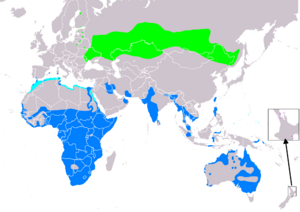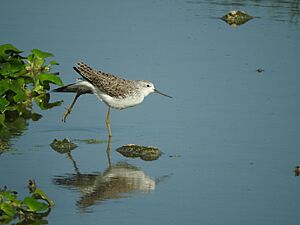Marsh sandpiper facts for kids
Quick facts for kids Marsh sandpiper |
|
|---|---|
 |
|
| Winter plumage | |
| Conservation status | |
| Scientific classification | |
 |
|
| Range of T. stagnatilis Breeding Non-breeding Passage Vagrant (seasonality uncertain) |
The marsh sandpiper (Tringa stagnatilis) is a small wader, which is a type of bird that likes to spend time near water. It's a kind of shank, a group of birds known for their long legs. These birds make their homes in open, grassy wetlands like steppes (large grasslands) and taiga (forests near the Arctic) from eastern Europe all the way to the Russian Far East.
The name Tringa comes from an old Neo-Latin word for a wading bird. The second part of its name, stagnatilis, comes from the Latin word stagnum, which means "swamp." So, its name basically means "swamp wader"!

Contents
What Does the Marsh Sandpiper Look Like?
The marsh sandpiper looks a bit like a smaller, more graceful greenshank. It has a long, thin bill and very long, yellowish legs.
When it's time to breed, its feathers (called plumage) are greyish-brown. In winter, its feathers become much paler. When it flies, you can see a white wedge shape on its back.
This bird is related to the common redshank and the wood sandpiper. These birds often have red or reddish legs. When they are breeding, their upper feathers are usually a light brown with some darker spots. They also have faint brownish spots on their chest and neck.
Marsh sandpipers are about 22–26 cm (8.7–10.2 in) long. Their wings can spread out to 55–59 cm (22–23 in) wide. They are quite light, weighing between 45–120 g (1.6–4.2 oz).
Where Do Marsh Sandpipers Live?
Marsh sandpipers breed in a large area called the Palearctic. This region includes Europe, Asia, and parts of North Africa.
These birds are migratory, which means they travel long distances. Most of them spend their winters in Africa and India. Some also fly to Southeast Asia and Australia. They prefer to spend the winter in freshwater wetlands, like swamps and lakes. You usually see them alone or in small groups.
Sometimes, marsh sandpipers are seen in North America, but this is very rare. Most of these rare sightings happen in Alaska and California. In 2022, a marsh sandpiper was seen in Ontario, Canada. This was the first time one had been recorded there! Many bird watchers traveled from far away just to see it.
Protecting Marsh Sandpipers
The marsh sandpiper is one of the birds protected by the Agreement on the Conservation of African-Eurasian Migratory Waterbirds (AEWA). This agreement helps protect birds that travel between Africa and Eurasia.
Images for kids



